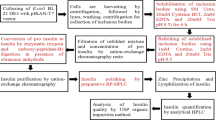Abstract
It has long been believed that amino acids comprising proteins of all living organisms are only of the l-configuration, except for Gly. However, peptidyl d-amino acids were observed in hydrolysates of soluble high molecular weight fractions extracted from cells or tissues of various organisms. This strongly suggests that significant amounts of d-amino acids are naturally present in usual proteins. Thus we analyzed the d-amino acid contents of His-tag-purified β-galactosidase and human urocortin, which were synthesized by Escherichia coli grown in controlled synthetic media. After acidic hydrolysis for various times at 110°C, samples were derivatized with 4-fluoro-7-nitro-2, 1, 3-benzoxadiazole (NBD-F) and separated on a reverse-phase column followed by a chiral column into d- and l-enantiomers. The contents of d-enantiomers of Ala, Leu, Phe, Val, Asp, and Glu were determined by plotting index d/(d + l) against the incubation time for hydrolysis and extrapolating the linear regression line to 0 h to eliminate the effect of racemization of amino acids during the incubation. Significant contents of d-amino acids were reproducibly detected, the d-amino acid profile being specific to an individual protein. This finding indicated the likelihood that d-amino acids are in fact present in the purified proteins. On the other hand, the d-amino acid contents of proteins were hardly influenced by the addition of d- or l-amino acids to the cultivation medium, whereas intracellular free d-amino acids sensitively varied according to the extracellular conditions. The origin of these d-amino acids detected in proteins was discussed.





Similar content being viewed by others
Abbreviations
- NBD-F:
-
4-fluoro-7-nitro-2,1,3-benzoxadiazole
- HPLC:
-
High performance liquid chromatography
- IPTG:
-
Isopropyl-β-d-thiogalactopyranoside
References
Buczek O, Yoshikami D, Bulaj G, Jimenez EC, Olivera BM (2005) Post-translational amino acid isomerization: a functionally important d-amino acid in an excitatory peptide. J Biol Chem 280:4247–4253
Calendar R, Berg P (1967) d-Tyrosyl RNA: formation, hydrolysis and utilization for protein synthesis. J Mol Biol 26:39–54
Casadaban MJ, Martinez-Arias A, Shapira SK, Chou J (1983) Beta-galactosidase gene fusions for analyzing gene expression in Escherichia coli and yeast. Methods Enzymol 100:293–308
D’Aniello A (2007) d-Aspartic acid: an endogenous amino acid with an important neuroendocrine role. Brain Res Rev 53:215–234
Dedkova LM, Fahmi NE, Golovine SY, Hecht SM (2006) Construction of modified ribosomes for incorporation of d-amino acids into proteins. Biochemistry 45:15541–15551
Fujii N, Satoh K, Harada K, Ishibashi Y (1994) Simultaneous stereoinversion and isomerization at specific aspartic acid residues in alpha A-crystallin from human lens. J Biochem 116:663–669
Fujii N, Takemoto LJ, Momose Y, Matsumoto S, Hiroki K, Akaboshi M (1999) Formation of four isomers at the asp-151 residue of aged human alpha A-crystallin by natural aging. Biochem Biophys Res Commun 265:746–751
Geiger T, Clarke S (1987) Deamidation, isomerization, and racemization at asparaginyl and aspartyl residues in peptides. Succinimide-linked reactions that contribute to protein degradation. J Biol Chem 262:785–794
Hamase K, Homma H, Takigawa Y, Fukushima T, Santa T, Imai K (1997) Regional distribution and postnatal changes of d-amino acids in rat brain. Biochim Biophys Acta 1334:214–222
Heck SD, Siok CJ, Krapcho KJ, Kelbaugh PR, Thadeio PF, Welch MJ, Williams RD, Ganong AH, Kelly ME, Lanzetti AJ et al (1994) Functional consequences of posttranslational isomerization of Ser46 in a calcium channel toxin. Science 266:1065–1068
Homma H (2007) Biochemistry of d-aspartate in mammalian cells. Amino Acids 32:3–11
Konno R, Brückner H, D’Aniello A, Fisher GH, Fujii N, Homma H (2007) d-amino acids: a new frontier in amino acid and protein research. Nova Science Publishers, New York
Long Z, Nimura N, Adachi M, Sekine M, Hanai T, Kubo H, Homma H (2001) Determination of d- and l-aspartate in cell culturing medium, within cells of MPT1 cell line and in rat blood by a column-switching high-performance liquid chromatographic method. J Chromatogr B Biomed Sci Appl 761:99–106
Mustafa AK, Kim PM, Snyder SH (2004) d-Serine as a putative glial neurotransmitter. Neuron Glia Biol 1:275–281
Nagata Y, Fujiwara T, Kawaguchi-Nagata K, Fukumori Y, Yamanaka T (1998) Occurrence of peptidyl d-amino acids in soluble fractions of several eubacteria, archaea and eukaryotes. Biochim Biophys Acta 1379:76–82
Nishikawa T (2005) Metabolism and functional roles of endogenous d-serine in mammalian brains. Biol Pharm Bull 28:1561–1565
Roher AE, Lowenson JD, Clarke S, Wolkow C, Wang R, Cotter RJ, Reardon IM, Zurcher-Neely HA, Heinrikson RL, Ball MJ et al (1993) Structural alterations in the peptide backbone of beta-amyloid core protein may account for its deposition and stability in Alzheimer’s disease. J Biol Chem 268:3072–3083
Soutourina J, Plateau P, Blanquet S (2000) Metabolism of d-aminoacyl-tRNAs in Escherichia coli and Saccharomyces cerevisiae cells. J Biol Chem 275:32535–32542
Takayama T, Ogawa T, Hidaka M, Shimizu Y, Ueda T, Masaki H (2005) Esterification of Escherichia coli tRNAs with d-histidine and d-lysine by aminoacyl-tRNA synthetases. Biosci Biotechnol Biochem 69:1040–1041
Whittington CM, Koh JM, Warren WC, Papenfuss AT, Torres AM, Kuchel PW, Belov K (2009) Understanding and utilising mammalian venom via a platypus venom transcriptome. J Proteomics 72:155–164
Acknowledgements
We thank Prof. Hidenori Watanabe, Department of Applied Biological Chemistry, The University of Tokyo, and Prof. Keiichiro Ogawa, Graduate School of Arts and Sciences, The University of Tokyo, for the helpful discussions.
Author information
Authors and Affiliations
Corresponding author
Rights and permissions
About this article
Cite this article
Miyamoto, T., Sekine, M., Ogawa, T. et al. Detection of d-amino acids in purified proteins synthesized in Escherichia coli . Amino Acids 38, 1377–1385 (2010). https://doi.org/10.1007/s00726-009-0348-2
Received:
Accepted:
Published:
Issue Date:
DOI: https://doi.org/10.1007/s00726-009-0348-2




